How to Cook Squash: Acorn, Butternut, and Spaghetti
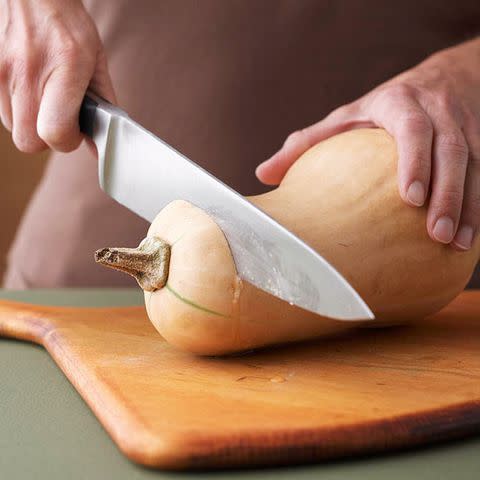
Acorn squash, spaghetti squash, and butternut squash are just a sampling of varieties of winter squash. Learn how to prepare squash in a few simple steps.
Winter squash have hard, thick skins, seeds in the middle, and dense, firm flesh that ranges from pale yellow to deep orange. They also require longer cooking times than other vegetables. Well-known varieties of winter squash include acorn, buttercup, butternut, Hubbard, spaghetti, delicata, and turban. Winter squash are good sources of vitamins A and C, as well as riboflavin and iron. Read on for ways to prepare the three most popular winter squash varieties.
The Most Popular Winter Squash Types
The most popular winter squash— spaghetti, acorn, and butternut—are plentiful during the fall and winter months.
Acorn Squash: Green varieties of acorn squash are typically what you see in the produce aisle. Harvested when fully mature, acorn squash should weigh 1 to 3 pounds and have deep green, dull skin with spots of orange. Shiny skin means the squash was harvested too early. Store uncut acorn squash up to one month in a cool, dry place (50°F to 55°F).
Butternut Squash: Aptly named after its best characteristics—“smooth as butter and sweet as a nut”—the butternut was developed by a Massachusetts farmer in the ’40s. Pound for pound, butternuts yield more flesh than most winter squash. Pick ones that are heavy—this signals moist, dense flesh—and avoid any with soft spots and blemishes. Stored whole in a cool, dark place, butternuts will last at least 3 and up to 6 months.
Spaghetti Squash: Time in the oven magically transforms the inside flesh of this plain-Jane squash into veggie noodles—spiralizer not required. When selecting, look for firm, heavy squash that are pale to dark yellow in color with dry, corklike stems. Store whole squash in a cool, dark place up to 3 months or at room temp for up to 1 month.
Selecting and Storing Squash
When selecting, look for firm, heavy squash that are pale to dark yellow in color with dry, corklike stems. Store whole squash in a cool, dark place up to 3 months or at room temp for up to 1 month.
Winter squash are available year-round but reach their peak from early fall through the winter.
Look for winter squash that seem heavy for their size.
They should have a hard rind that is free of bruises, dents, and mold.
The hard rind on winter squash allows them to be stored longer than summer squash. They do not require refrigeration.
How to Cut Squash
Use caution when cutting butternut squash or other winter varieties. While it may seem intimidating, it's easy to cut an acorn or butternut squash for roasting, cooking, and more.

Step 1: Remove Stem End
Using a large, sturdy knife, cut off about 1 inch from the stem end of the squash.
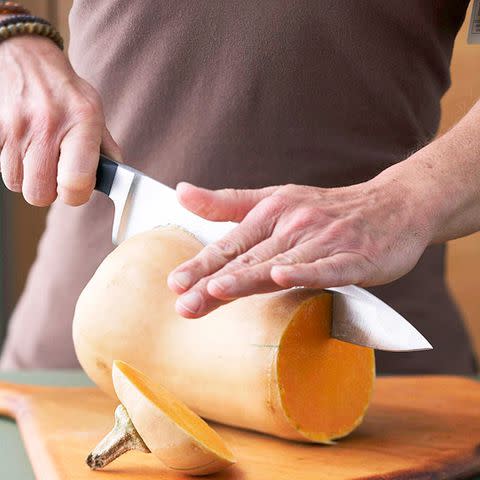
Step 2: Cut in Half
Insert the knife lengthwise into the center of the squash. Use your other hand to gently press the knife all the way through the squash.
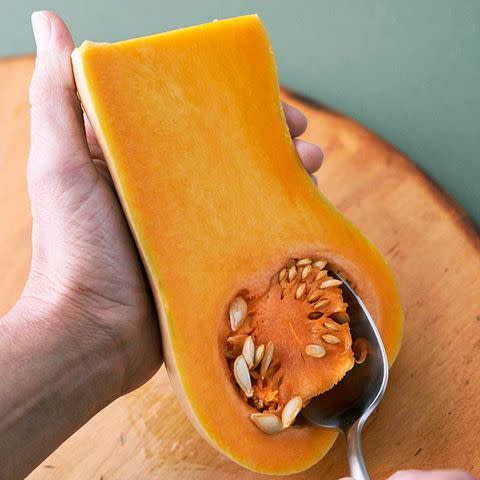
Step 3: Remove Seeds
Using a large spoon, scrape the seeds and fibrous strings from each squash half. You may discard the seeds or save them for roasting.
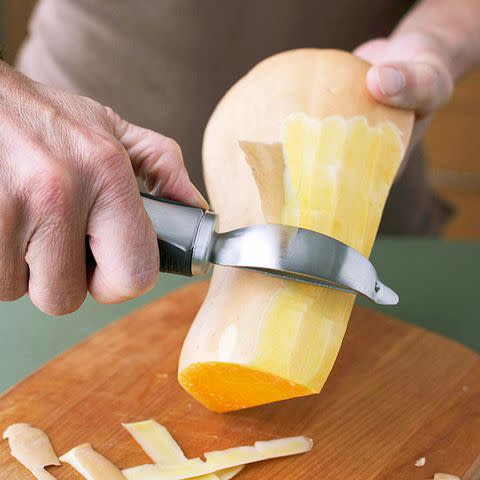
Step 4: Peel the Squash
Hold a squash half at an angle on your cutting board and use a sturdy vegetable peeler to peel down its length. For winter squash with ridged skin, such as acorn squash, use a sharp knife rather than a vegetable peeler to remove the skin. The squash is now ready to be chopped as desired for using in recipes.
:29 Butternut Squash Recipes You'll Want to Make All Season
How to Roast Squash
Baking is the simplest way to cook acorn and butternut squash because it doesn't require peeling the squash first. Get our best squash recipes.
Preheat oven to 350 degrees F.
Using a sharp, sturdy knife, cut the winter squash in half. Use a large, sturdy spoon to remove the seeds.
Place the squash halves in a shallow roasting pan, cut sides up.
Place 1 tablespoon butter in each squash half. If desired, sprinkle each half with salt, brown sugar, fresh or dried herbs, and/or cinnamon-sugar. You may also drizzle each half with honey or maple syrup.
Bake the squash for 30 to 40 minutes or until tender.
Allow the squash to cool slightly after baking. Slice the squash halves into individual servings or scrape the flesh into a bowl.
Test Kitchen Tip: If using small winter squash, each baked half may be served whole.
How to Cook Spaghetti Squash
Spaghetti squash differs from other varieties of winter squash because it possesses a mild, less-sweet flavor and very fibrous flesh that, when removed, looks like spaghetti. Spaghetti squash math: one 2-pound squash yields about 3 cups shredded squash “noodles.”
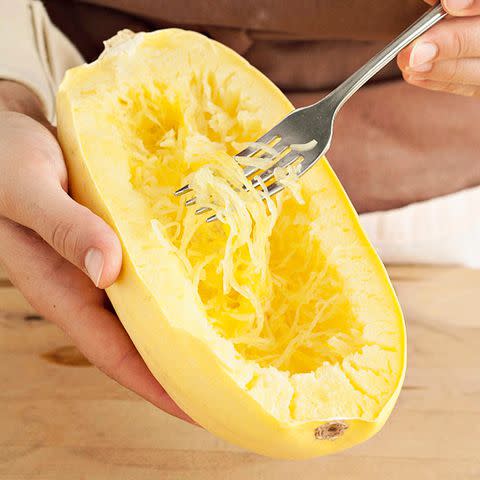
Cooking spaghetti squash is easy and results in tender, noodle-like strands. Get our best methods for making spaghetti squash.
Tips for Serving Spaghetti Squash
Use a fork to loosen the fibers.
Using a large, sturdy spoon, scrape the fibers from the squash.
Serve spaghetti squash in place of pasta with various sauces, such as Bolognese Sauce.
false
